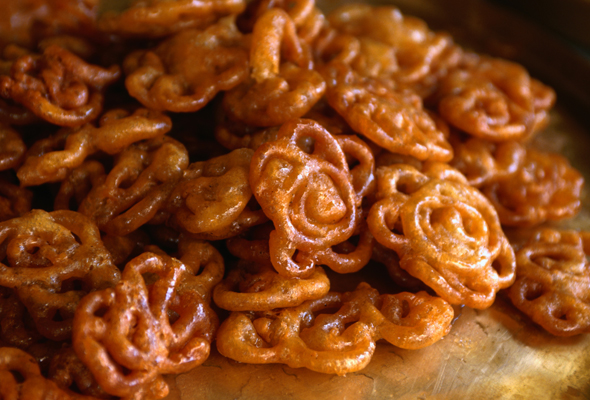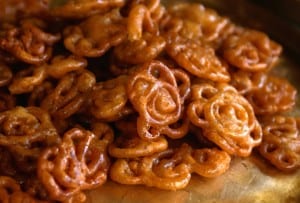
Jalebis are typically orange-colored coils of deep-fried batter prepared from maida (all-purpose flour), which are dunked in an intensely sweet sugar syrup. Sizzled in ghee (clarified butter) or vegetable oil, jalebis are customarily eaten piping hot from the kadai (a woklike vessel). A piping bag or a plastic bottle with a pointed nozzle is a neat and easy way of making the signature jalebi squiggle. These squiggly delights are frightfully sticky yet traditionally eaten by hand.–The Editors of Lonely Planet
LC Jalebi Jibber Jabber Note
Our resident jalebi expert, recipe tester Sita Krishnaswamy, recently explained to us the marvel that are these little blobs of fried batter. The curious curlicues of sticky sweet fried batter are perhaps best likened to diminutive funnel cakes and are traditional during the Indian Festival of Lights, which is really more a Festival of Sweets considering how dessert-minded everyone seems on this day. And you’re going to want to be on a first-name basis with them. In terms of making jalebi, Sita continues, the resting time for the batter is an absolute must in order to attain jalebi that are fluffy, not dense. Jalebi are traditionally turned a vibrant shade by adding a few drops of orange or yellow food coloring to the batter. And, cautions Sita, it may take a little practice to form that small squigglelike design that’s sorta a coil yet sorta not. (Truth be told, you could make any design, although Sita prefers concentric circles for practical reasons, cautioning that crisscrossing the batter squiggles makes for bumpy contact points that require longer to cook through, thereby running the risk of overcooking the rest of the jalebi. Can you see why we love Sita so?!) Happy Diwali!

Indian Fried Dough ~ Jalebi
Equipment
- Deep-fry or candy or instant-read thermometer
Ingredients
For the jalebi
- 1 cup all-purpose flour (labeled maida in Indian stores)
- 1 teaspoon gram flour (besan) (optional)
- 1/2 teaspoon yeast
- 1/2 teaspoon granulated sugar
- 1/2 teaspoon mild vegetable oil, plus more for frying
- About 1 cup lukewarm water
- A few drops orange or yellow food coloring, (optional)
For the syrup
- 1 cup granulated sugar
- 1 cup water
- Pinch ground cardamom
- Pinch crushed saffron threads
- 1 to 2 teaspoons fresh lemon juice
Instructions
Make the jalebi
- In a large bowl, combine the all-purpose flour, gram flour, if using, yeast, and sugar and mix well. Make a well in the center of the flour mixture. Pour the oil, almost all of the water, and the food coloring, if using, into the well and stir until no lumps remain. The texture should be slightly runny, like pancake batter. (This is also known as “ribbon consistency,” which simply means that when the batter drips from a spoon, it falls like a ribbon onto the batter that remains in the bowl.) If necessary, add a touch more water. Let the batter rest at room temperature for 20 minutes.
Make the syrup
- Place all the syrup ingredients in a small saucepan and bring to a gentle boil. Cook until the sugar dissolves and the mixture thickens slightly, 5 to 7 minutes. Reduce the heat to the lowest possible setting to keep the syrup warm while you fry the jalebi.
Fry the jalebi
- Place a wire rack over a baking sheet or grab a brown paper bag and place it on your work surface. Pour enough oil into a skillet or a deep-sided pot to reach a depth of about 1 1/2 inches and heat over medium-high heat. The oil is ready when you drop a tiny amount of batter into the oil and it immediately sizzles and resurfaces without changing color. (If the batter colors straight away, the oil is too hot. For those of you who crave certainty, attach a deep-fry or candy or instant-read thermometer to the side of the pot and heat until the oil registers about 350°F (176°C).)
- Pour the rested jalebi batter into a piping bag, a plastic squeeze bottle with a pointed nozzle, or a large resealable plastic bag whose lower corner you snipped off with scissors. (We find a plastic squeeze bottle to offer the most control and ease in creating your jalebi squiggles.)
- Squeeze some of the jalebi batter into the oil in a squiggly coiled circle or flowerlike shape approximately 2 inches in diameter. Repeat 2 or 3 times to create just enough jalebi so as not to crowd the pan. Fry the jalebi until they’re the color of golden honey on both sides. Using a slotted spoon or tongs, gently transfer the jalebis to the pan of warm syrup. Let soak, turning at least once or twice, for no more than 2 to 3 minutes. Transfer the jalebis to the wire rack or brown paper bag. Serve immediately or let cool completely and rewarm in a low oven or in the microwave.

Explore More with AI
Nutrition
Nutrition information is automatically calculated, so should only be used as an approximation.
Recipe Testers’ Reviews
Jalebis are outstanding. This is a very versatile dessert that can be street food and can also be served at weddings. This recipe worked quite well. I would definitely add some yellow or orange food coloring to the batter, as is the custom in India. I used a squeeze bottle to make the jalebis. I cooled the jalebis completely and then warmed them in the microwave before serving.











Very nice and tasty.
So glad you enjoyed it, Sacoor.